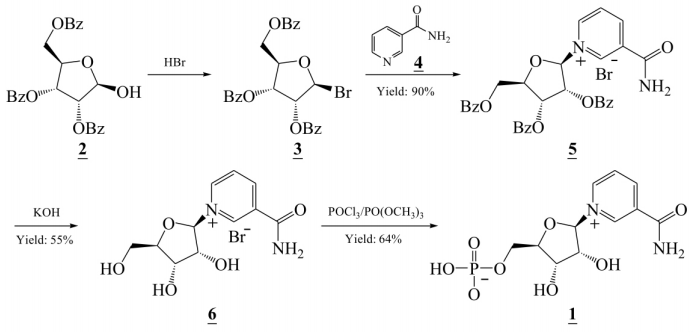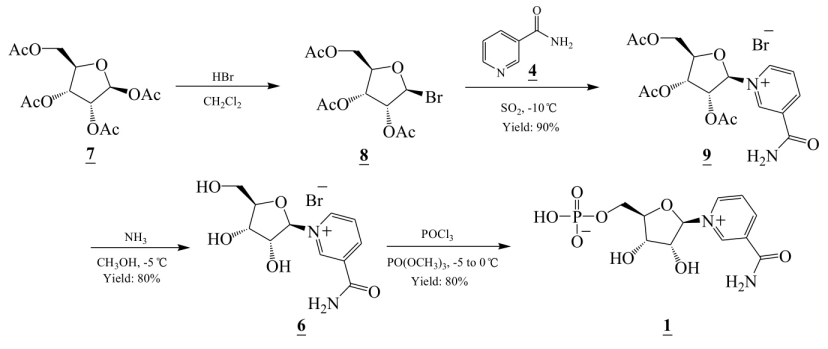PharmaSources/YuntianJanuary 28, 2021
Tag: NMN , Anti-Aging , Obesity
As a new star API, NMN, i.e., nicotinamide mononucleotide, is a reaction product of nicotinamide phosphoribosyltransferase (NAMPT). It mainly serves as a key precursor of NAD+ in the body and exerts physiological functions through transformation, such as activating NAD+ substrate-dependent enzyme: Sirt1 (histone deacetylase), regulating cell survival and death, and maintaining redox status. Studies have confirmed that NMN levels are associated with various diseases such as cardiovascular and cerebrovascular diseases, neurodegenerative diseases, diabetes, and obesity. Let’s take a look.

Figure I NMN Structural Formula
From the perspective of medicinal functions, the functions of NMN currently proven include:
1. Alleviating and improving ischemic heart and brain tissue damage
a. Stroke therapeutic effect. Stroke is an acute cerebrovascular disease caused by blood circulation disorders in the brain, which is characterized by high mortality and a high disability rate. According to research, NMN could activate the Nampt-NAD+ pathway, protect cranial nerves, promote blood vessel and nerve regeneration, and well protect nerve damage caused by a cerebral hemorrhage and hemorrhagic transformation, therefore, it has anti-stroke potential.
b. Cardiac ischemia-reperfusion therapeutic effect. As a fatal ischemic injury, cardiac ischemia-reperfusion is accompanied by unavoidable myocardial cell death and severe organ dysfunction. Ischemic preconditioning (IPC), an endogenous defense mechanism mediated by activation of Sirt1, can protect myocardial viability during transient ischemia-reperfusion. According to research, NMN could protect the heart by mimicking the protective effect of IPC.
2. Improving oxidation-related degenerative diseases and body dysfunctions
a. Alzheimer’s disease (AD) therapeutic effect. Studies have found that mitochondrial structure and function abnormalities are one of the pathogenic factors of AD. NMN can promote the energy metabolism of mitochondria, to play an important role in improving cognitive function and memory function.
b. Parkinson’s disease (PD) therapeutic effect. Studies have confirmed that NMN could improve neural cell survival, stabilize NAD+ and ATP levels, inhibit apoptosis, resist energy injury, and improve mitochondrial inhibitor-induced energy metabolism disorders, thus benefiting the treatment of PD.
c. Vascular dysfunction therapeutic effect. Studies have confirmed that NMN could reduce vascular oxidative stress and improve atherosclerosis and vascular dysfunction; furthermore, NMN could reduce collagen accumulation in blood vessels and thus increase arterial elastin accumulation, reduce human atherosclerosis and delay pulse aging.
d. Furthermore, NMN has also been proven to have the effects of treating acute kidney injury, delaying aging, and treating degenerative sight diseases.
If you are looking for biological pharma products that have medical functions, then Pharmasources would be your best choice.
3. Treating metabolic disorders
NMN is mainly used in metabolic disorders for improving diabetes and obesity. Studies have found that NMN could improve islet function in high-fructose mice by participating in glucose metabolism, anti-inflammatory and apoptotic processes; furthermore, NMN could improve islet function by catalyzing the biosynthesis of NAD+ in mammals, thus restoring insulin secretion; moreover, the rise of NAD+ levels could enhance mitochondrial energy metabolism, thus achieving a weight loss effect similar to that of exercise.
NMN is also getting more and more attention in China, and its demand as an API is increasing. As such, I’d like to show two synthetic processes for your reference.

Figure II NMN Synthetic Process I
The first one is obtaining the target product NMN by bromination, nicotinamide substitution, benzoyl group deprotection, and phosphorylation, with tribenzoyl-β-D-ribose (2) as the starting material, developed by Mikhailopulo, et al. This process has shorter steps and higher total yield. However, it has problems such as environmental unfriendliness and expensive raw materials.

Figure III NMN Synthetic Process II
The second one is a modified process of Process I. The process is based on tetra-O-acetyl-D-ribose as the raw material and also obtains the target product NMN by bromination, nicotinamide substitution, benzoyl group deprotection, and phosphorylation. Compared with Process I, this process is characterized by cheaper and easier availability of raw materials, milder reaction conditions, and higher atom economy.
To sum up, researchers have not stopped developing better processes for NMN, and at the same time, the demand for NMN for medicinal use will continue to increase as the research on NMN goes deeper. Secondly, the health care functions of NMN, such as anti-aging and obesity improving functions, have been recognized in succession, and the demand for its use in health foods is expected to grow significantly, making it a drug and potential health food worthy of attention.
References:
1. Progress on research and application of nicotinamide mononucleotides, 2018;
2. Progress in Synthsis of β-Nicotinamide Mononucleotide,2020;
3. Advance in Synthesis of β-Nicotinamide Mononucleotide,2020.
Yuntian, Ph.D. in medicinal chemistry, is mainly engaged in small molecule drug research, especially good at small molecule drug synthesis process and later stage drug development research. He has completed the synthesis and activity evaluation of multiple anti-cancer drug molecules.


Contact Us
Tel: (+86) 400 610 1188
WhatsApp/Telegram/Wechat: +86 13621645194
+86 15021993094
Follow Us:




 Pharma Sources Insight July 2025
Pharma Sources Insight July 2025


